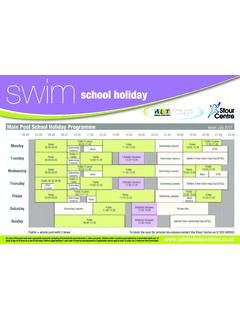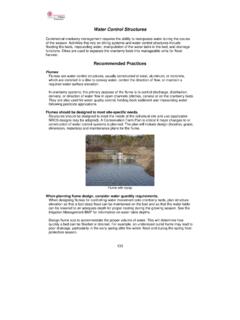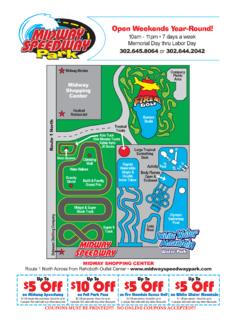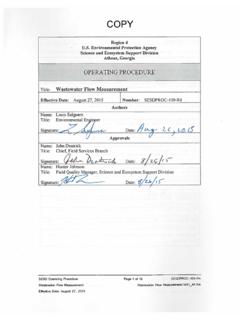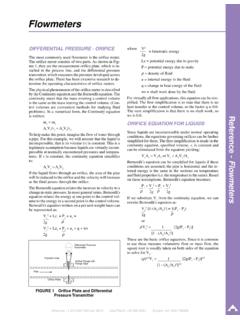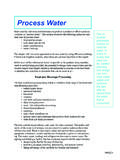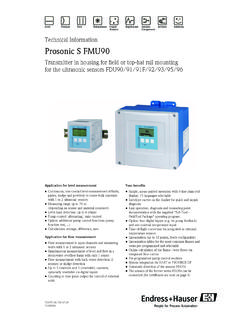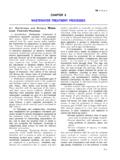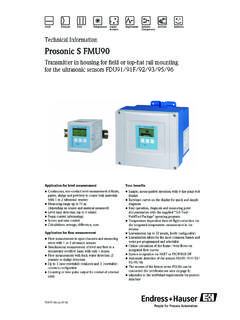Transcription of Technical Note: A Practical Guide to Flow …
1 Technical Note: A Practical Guide to Flow measurement This monograph is designed to aid you in field and laboratory studies with a fluorometer and fluorescent dyes. The fluorometric techniques described have major advantages over other available techniques. Learn how to: Calibrate flow meters on site Calibrate weirs and flumes in the field Correlate stream-level gauges with the flow rate Measure stream flow directly, without a weir, flume, or level gauge even under ice Measure canal, drainage ditch, and sewer flow with portable equipment Study sewer system infiltration, without cleaning Study time-of-travel in small streams or over hundreds of miles in large rivers Discover residence time and channeling in settling basins and chlorine contact chambers In addition to these studies, the fluorometer can be used to determine clarity,* chlorophyll,* and pheophytin.
2 * It can also perform circulation, dispersion and plume studies.* While this monograph focuses primarily on field studies, the fluorometer is used for thousands of fluorometric analysis procedures in the laboratory. Flow measurements will help you understand the theory, select the equipment, and solve the problem of flow measurement in the laboratory, or backpacking into the wilderness. * Monographs are available from Turner Designs. 998-5000 Revision A Page 1 of 29. Technical Note: A Practical Guide to Flow measurement TABLE OF CONTENTS. A. INTRODUCTION 3 G. measurement TECHNIQUE 15. B. EXAMPLES 4 1. Sample Characteristics 2. Calibration C. FLOW RATE THEORY 5 3. Turbidity 4. Sample Temperature 1. Constant-Rate Injection 2. Slug Injection H. SAMPLING SYSTEMS 18. 3. Velocity Method 4.
3 Multi-channel Situations 1. Grab, Manual 5. Infusion and Leakage Studies 2. Grab, Automatic 6. Ground Water 3. Continuous I. EQUIPMENT 19. D. FLOW-RATE PRACTICE 9. 1. Fluorometers 1. Injection Rate 2. Recorders 2. Site Location 3. Power Sources 3. Dye Loss 4. Dye Injectors 5. Samplers E. TIME-OF-TRAVEL PRACTICE 13. J. DYES 23. 1. Introduction 2. Dye Requirements 1. Introduction 3. Dye Injection 2. Toxicity & Approval 4. Site Location 3. Stability 5. Interpretation of Data 4. Solubility 5. Water Condition F. RESIDENCE TIME 15. 6. Detectability & Background 7. Filters & Light Sources 8. Aesthetics 9. Sources of Dyes 998-5000 Revision A 05/31/2001 Page 2 of 29. Technical Note: A Practical Guide to Flow measurement A. INTRODUCTION Knowing the exact concentration of the injected dye and downstream dye is unimportant.
4 You may, The use of fluorescent dyes and a fluorometer yields however, calibrate your injector in cubic feet per a nearly perfect tracer system, with the following second (cfs), gallons per minute (gpm), or acre feet advantages: per hour; these will be the measured flow rate units. LOW COST. $.50 of dye will measure a flow rate of Continuous injection and determination of dilution is 100 cubic feet per second. not the only method used, although it is easiest and more accurate, especially in natural streams. DIRECT measurement . Readings may be made Sometimes it is more convenient to pour a small directly on a continuous-flow sample or on an amount of dye, all at once, into the stream. The individual sample, without processing. derivation of flow rate from the downstream measurements is less obvious, but this slug LOW TRACER CONCENTRATION.
5 A fluorometer technique is still relatively simple. Its most common can detect tracer concentrations as low as parts use is to determine time-of-travel. Introducing a slug per billion (ppb). Most studies yield concentrations of dye at point A and noting the time it takes to between 1 and 10 ppb. Detection would be appear at point B obviously gives you time-of-travel. impossible without a fluorometer. With this technique you can also find the rate of flow with just a few minutes more calculation. DURABLE AND COMPACT. The system is ideal for use in remote locations as all parts are durable and The National Bureau of Standards (NBS) and the easily transportable. Environmental Protection Agency (EPA) have each included, in special publications, a discussion of ACCURATE. Fluorescent tracer techniques are so chemical additive (dilution) techniques for measuring accurate that they are used to calibrate flow meters.
6 Flow (30, 31). The NBS publication is a general Where flow meters, weirs and other techniques are discussion covering both the steady-state and slug impractical, a fluorometer continues to yield accurate methods. The EPA publication mentions the wide use measurements. and convenience of fluorescent dyes. CONVENIENT. The low tracer concentration required The slug technique has another advantage. If it is makes handling the tracers much easier. injected at the inlet of a contact chamber or settling basin, the profile of tracer concentration versus time STABLE. Because of their stability, samples at the exit will yield minimum, mean, and median collected in the field may be returned to the retention times, and will detect channeling. laboratory for measuring. The examples in this monograph should illustrate, in The following example of a "typical" flow relative detail, the theory, practice, equipment measurement will illustrate the practicality of a requirements, and possible problems in determining fluorometer in tracer studies.
7 Flow rate and time-of-travel in typical situations. It is impossible to cite all situations and literature To measure the rate of flow (discharge) of a small pertaining to the subject. However, several detailed stream, inject a solution of dye into the stream at a and readily available articles are cited, and reading is steady rate of one milliliter per minute. Downstream, recommended where appropriate. the dye has been diluted by a factor of ten million. Conclusion: the stream has a flow rate of ten million milliliters per minute, or cubic feet per second. As is evident from the example, it is only necessary to know the dilution factor, or the concentration downstream relative to that of the injected dye. 998-5000 Revision A 05/31/2001 Page 3 of 29. Technical Note: A Practical Guide to Flow measurement B.
8 EXAMPLES not enough dye was used. This will be discussed in detail in section G3 on Turbidity. Twenty-four tests of dye technique in 15 different field situations have been summarized by Kilpatrick (1). Kilpatrick reiterates the need for an in-place Discharge could be accurately measured by meter or calibration technique for many of the permanent weir in these situations, although the probable devices used for fluid discharge measurements (3). accuracy of the latter methods was not included. Flow Removal of these instruments to the laboratory is rates ranged from 1 to 3,000 cubic feet per second. inconvenient and usually expensive. In addition, the The studies included both smooth and turbulent flow hydraulic and sediment conditions existing in the field in various types of natural streams, canals (lined and may be impossible to duplicate in the calibration unlined), concrete pipes, and even under ice.
9 Laboratory. Excellent correlations were found between the constant-rate dye dilution technique, and The researchers concluded that the constant-rate volumetric or other careful calibrations of an orifice, a injection (steady-state) technique compared favorably spillway, a sharp-crested weir and a trapezoid flume. to other techniques. The largest discrepancy was Discharge ranged from to 400 cfs. , but most were less than 2%. In addition, four parshall flumes, used to measure raw The single-slug technique was very accurate in sewage, were tested. With two of the flumes, the canals and other artificial conveyance structures, but measurements agreed within 3% of the ratings. Two was less accurate in natural streams. A portion of the others were discovered to be carrying more flow than inaccuracy in natural streams could be attributed to is allowed in the standard ratings.
10 As a result of the the manual sampling technique used in the study. dye technique, the correct rating brought the inflow/outflow budget of the sewage plant into Kilpatrick, et al., lists a large number of applications balance, correcting the considerable discrepancy. where the dye method is more convenient and/or accurate than other techniques. The dye method is Morgan, et al., uses the dye-dilution technique to very convenient and low in cost, including labor costs validate the performance of a single-stage, mixed- (1). flow, vertical turbine pump (32). The newly installed pump was operating to within of its design point Replogle, et al., demonstrates the accuracy of the of 70,000 gpm at 93 feet TDH. Periodic testing of single-slug technique in artificial structures. A large pumps to determine the necessity of overhaul laboratory flume was precisely calibrated at various becomes a relatively simple project with the dye- flow rates with gravimetric techniques.

